What are those 8 physiological disorders that every cotton farmer must be aware of? These disorders arise from environmental stresses, nutritional imbalances and chemical factors. They impact productivity significantly, depending on the growth stage, intensity of incidence, and loss of reproductive parts. How can we prevent this? Before preventing it, we should diagnose it. It’s crucial to differentiate between plant adaptations to stress (such as small leaves during drought) and physiological disorders in cotton.
Here, let us help you with 8 common physiological disorders in cotton crops, knowing their symptoms, causes, and management strategies.
1. Leaf Reddening: One of the Serious Physiological Disorders in Cotton
Symptoms:
Initially, leaf reddening appears in mature leaves, starting with yellow margins that gradually turn red. Eventually, the entire leaf becomes red, dries up and may shed.

Leaf reddening, one of the serious physiological disorders in cotton, also leads to the shedding of leaves and bolls from the plant, resulting in poor plant growth. If the severity increases, you may observe fewer bolls or no bolls on the plant, along with wilting of the plant.
Causes:
Nitrogen Deficiency: Low nitrogen levels in the soil or impaired uptake due to water stress or waterlogging.
High Boll Demand: During synchronised boll development, the high nutrient demand can divert nitrogen from the leaves.
Environmental Factors: Abrupt temperature drops, magnesium deficiency and chlorophyll degradation leading to anthocyanin accumulation (red pigment).
Pest Attack: Other causes also include the incidence of sucking pests. Pests like jassids are the main cause of red leaf disease in cotton. Not just jassids, but reddening can also be caused by viruses transmitted by Aphis gossypii, which mainly results in reduced boll weight and yield. Other than jassids and aphids, in certain cases, if Bemisia tabaci attacks the crop during the boll maturation stage, it results in leaf reddening.
Managing reddening in cotton is important because it can reduce cotton yield by 10-50%
Management:
If the incidence of leaf reddening in cotton exceeds 10-15%, it is important to take remedial measures.
Sowing Time: Adjust sowing time to avoid adverse conditions during boll development.
Foliar Sprays: Apply urea (1%) and magnesium sulphate (0.5%) at appropriate times.
Field Drainage: Ensure adequate drainage to prevent waterlogging.
Pest Control: Use recommended insecticides to manage pest-induced reddening.
Cultivar Selection: Choose resistant cultivars and maintain soil health through crop rotation and intercropping.
Nutrient Supply: Make sure to give enough nutrients, especially when the plants are flowering and forming bolls. If soil tests show a lack of nutrients, add phosphorus, potassium and sulphur to the soil before planting.
Soil application of DAP at the rate of 50 kg per hectare, under irrigated conditions reduces leaf reddening.
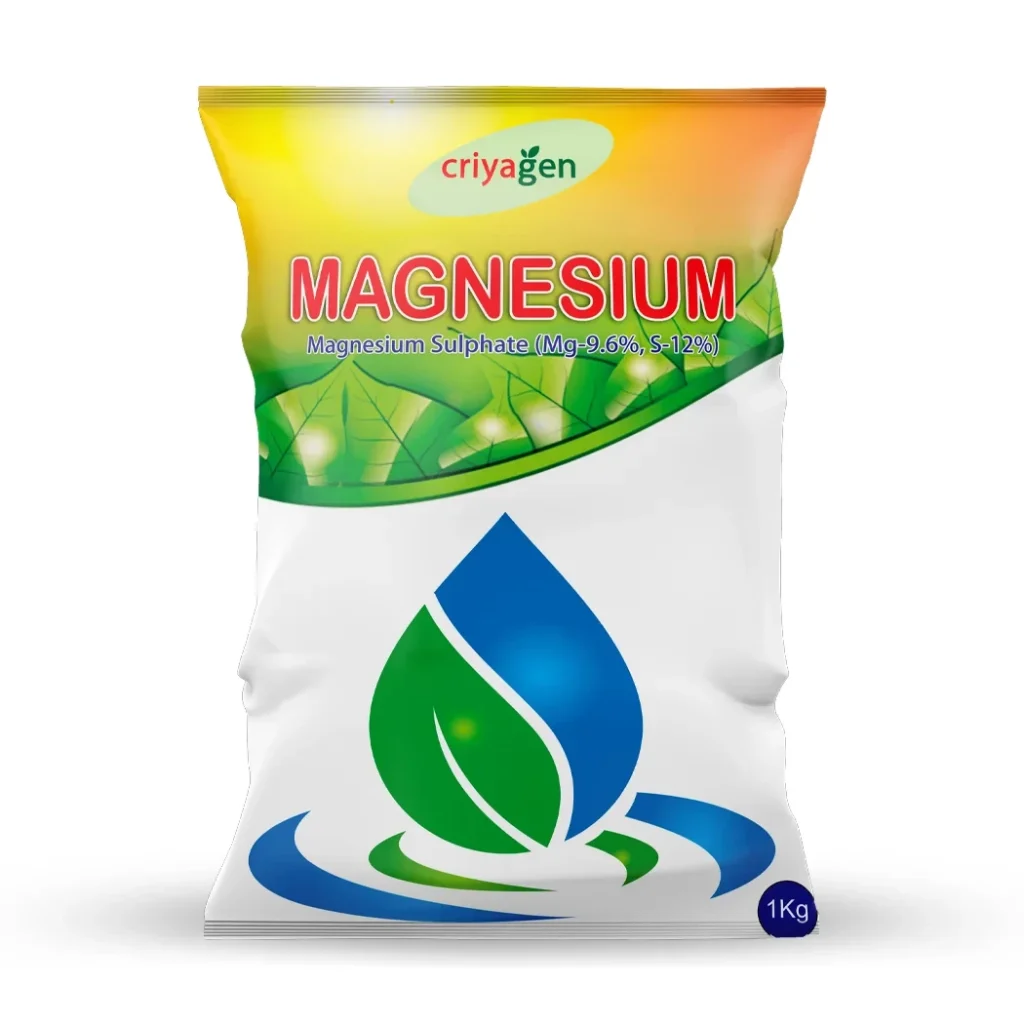
2. Parawilt / New Wilt
Symptoms
Affected cotton plants show wilt-like drooping, chlorotic leaves that turn bronze or red before drying. There is premature shedding of leaves and fruiting parts, and immature bolls may open prematurely. Wilted plants might recover but contribute minimally to yield.
The incidence of parawilt is high when cotton plants have a large canopy and heavy boll load.
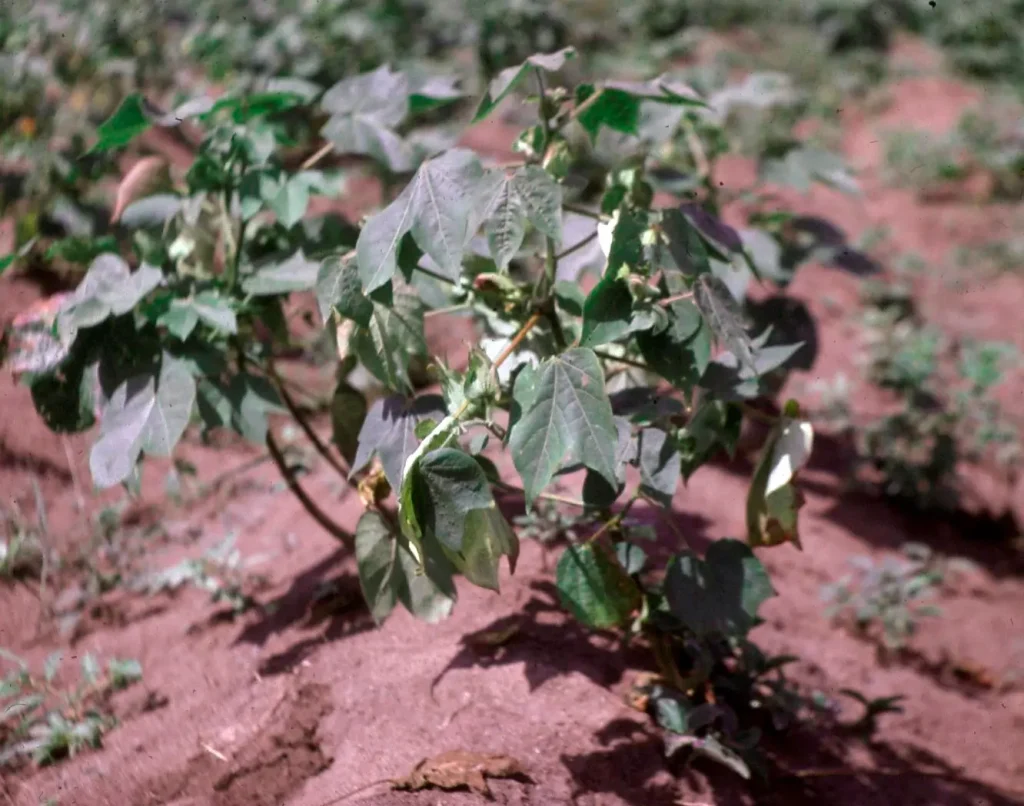
Causes
Susceptible Varieties: Certain hybrids and varieties are more prone to wilt.
Environmental Stress: High temperature and sunlight, followed by heavy rains or irrigation, particularly in heavy clay or poorly drained soils.
Parawilt occurs when the soil-plant-atmosphere continuum is disrupted due to adverse environmental conditions like waterlogging or soil saturation. This leads to poor root growth, as primary roots and root hairs are damaged by flooding, resulting in a 60 percent decrease in water intake. Additionally, high transpiration loss, where the plant requires more water, further worsens the problem due to the poor or damaged roots.
Management
Resistant Varieties: Plant wilt-tolerant varieties like G. arboreum and G. herbaceum.
Field Drainage: Ensure good field drainage to avoid waterlogging.
Irrigation Management: Provide irrigation during dry spells and avoid excessive fertilizers in heavy soils.
Vegetative Growth Control: Manage vegetative growth to reduce stress on plants.Fertiliser Application: Apply 2% urea through foliar spray and drench with 25 g of copper oxychloride per 10 litres of water near the root zone.
3. Leaf Drying / Burn
Symptoms
Young leaves at the top of the canopy show necrosis near the margins, which gradually moves inward, causing the leaves to dry up and shed. Under extreme conditions, the squares and developing bolls start drying up.
Causes
Leaf drying is commonly seen during boll development when there are high day and night temperatures, bright sunshine, and moisture stress during the flowering and boll development stages, often in problematic soils.
Management
Heat-Tolerant Genotypes: Select heat-tolerant genotypes.
Protective Irrigation: Provide irrigation during critical growth stages.
Soil Mulch: Use soil mulch to reduce water evaporation.
4. Bud and Boll Drying
Symptoms
Developing buds and bolls dry up, turn black and may crack, affecting lint and seed quality.
Causes
Non-availability of photoassimilates due to impaired enzyme activity is common in saline/alkaline soils and high temperatures. This disorder also occurs in light sandy soils with lower nitrogen levels. High temperatures and dry weather during flowering act as susceptible conditions for bud and boll drying to occur.
Management
Genotype Selection: Select suitable genotypes and adjust sowing dates to avoid extreme conditions. G.hirsutum genotypes are more prone to boll drying.
Nutrient Management: Correct nutrient deficiencies, particularly nitrogen, and provide frequent irrigation in saline soils.
5. Bad Boll Opening
Symptoms
Bad boll opening is oftenly called Tirak disease in cotton. Bolls crack prematurely and improperly, turning black and affecting fibre and seed quality.
In the initial stages, the leaves turn yellow, and later they become red. The capsule wall of the boll becomes tight and does not open completely.
Causes
The major causes of bad boll opening are subsoil salinity, light sandy soil, nitrogen deficiency in soil, low humidity, warm and dry weather during fruiting period.
It is also caused when there is low moisture and nutrient availability during boll formation.
Management
Sowing Dates: Adjust sowing dates so that boll formation stage is not affected and ensure proper nitrogen management.
Frequent Irrigation: Frequent irrigation can mitigate the effects of subsoil salinity.
Nutrient Application: Timely application of nitrogen in light sandy soils and use of growth retardants to control excessive vegetative growth.
6. Crinkle Leaf: One of the Major Physiological Disorders in Cotton
Symptoms
The first signs of crinkle leaf, caused by manganese toxicity, appear in younger leaves as interveinal chlorosis and cupping. Additionally, if you observe yellowing and necrosis of terminal buds, it is likely due to crinkle leaf disease.
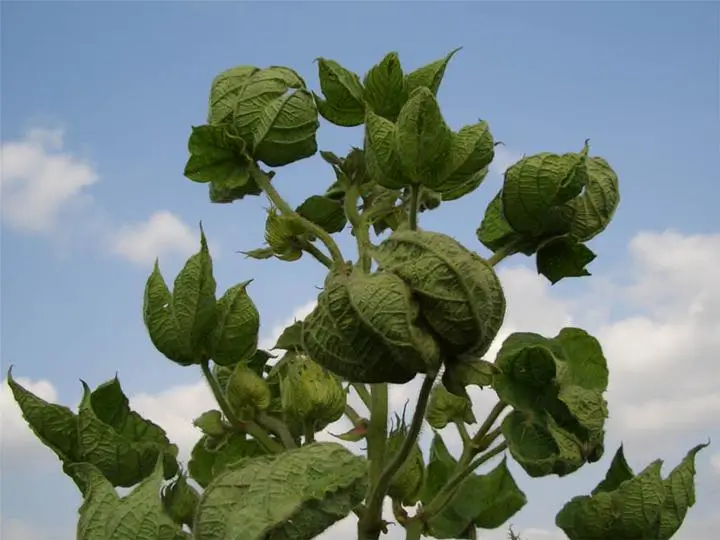
Cotton leaves show symptoms such as mottling, chlorosis, and distortion. Since this is caused by manganese toxicity, it results in iron and zinc deficiency.
Causes
The crinkle leaf disease is a major physiological disorder in cotton and is more prone to occur in acidic soils and in waterlogged conditions. Increased availability of nutrients in the soil and uptake lead to manganese toxicity in cotton plants.
It mainly occurs in waterlogged conditions and is a common problem in acidic soils.
Calcium deficiency in soil also leads to crinkle leaf disease in cotton.
Management
Gypsum Application: Apply gypsum to neutralise manganese toxicity and address calcium deficiency.
Field Drainage: Improve field drainage to avoid waterlogging.
7. Effect of 2,4-D
Symptoms
Abnormal changes in plant morphology cause leaves to droop and turn downward. This condition not only affects the leaves but also leads to malformed floral parts and bracts.
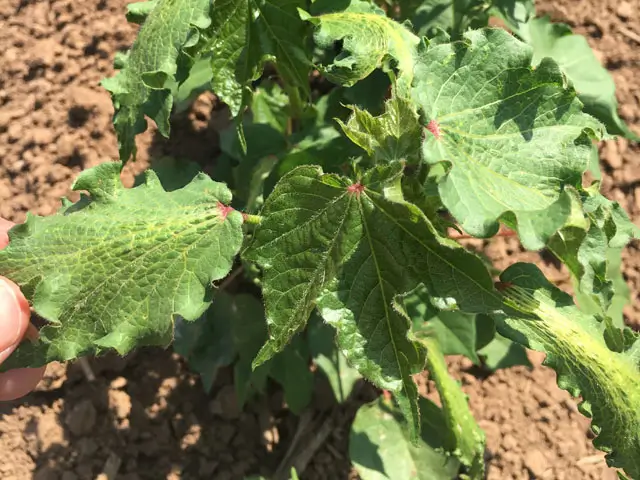
Additionally, narrow and elongated leaves with prominent veins can be observed, along with tubular flowers and elongated floral parts.
When a 2,4-D spray at 5 ppm is applied during flowering, it results in stem elongation.
In this condition, the leaves at the ends of the branches look like cups and feel tough like leather. The stems of these leaves might turn pink or purple.
Some parts of the plant turn yellow and fall off quickly. This happens faster when the plant is growing well. But if the plant isn’t growing well, the symptoms take longer to appear and aren’t as obvious, especially in older plants. The damaged leaves don’t get completely better, but new leaves that grow later on look normal eventually.
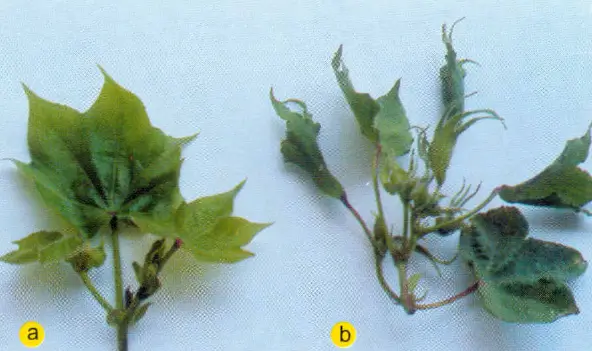
Causes
The foliar application of 2,4-D (at concentrations ranging from 5 to 50 ppm) on 70-day-old plants results in symptoms such as epinasty and drooping of meristematic leaves at lower concentrations.
At higher concentrations, not only does the bottom leaves exhibit epinastic symptoms, but the meristematic region also dries up. Additionally, the affected leaves show drastic reductions in photosynthesis, transpiration and stomatal conductance.
Management
Sprayer Hygiene: Avoid using contaminated sprayers; wash thoroughly if necessary.
Water or Urea Spray: Apply water or urea spray (1%) to minimise damage.Recovery Treatments: Use calcium carbonate (1.5%) or Gibberellic acid (50 ppm) to help recovery from low concentrations of 2,4-D.
8. Bud and Boll Shedding
Symptoms
Yellowing of Fruiting Parts: Fruiting parts that are about to abscise often turn yellow in colour due to nutrient limitations or hormonal imbalances.
Continuous Shedding of Young Squares: Young squares are indiscriminately and continuously shed, particularly under harsh growing environments.
Limited Boll Retention: Despite producing numerous squares, only a few bolls are retained for harvesting.
Shedding Magnitude: Shedding magnitude tends to be higher under adverse growing conditions, such as high temperatures, drought or waterlogging.
Limited Shedding of Older Bolls: Bolls beyond a certain age (10-12 days old) are oftenly shed.
Varietal Differences: Compact varieties tend to be less prone to shedding compared to other canopy architectures.
Causes
Abscission Layer Formation: Shedding begins with the formation of an abscission layer, which leads to the detachment of buds and bolls from the plant.
Competition for Resources: Heavy boll load and optimum canopy production lead to competition among developing organs for current photosynthates, increasing the likelihood of shedding if resource demands are not met promptly.
Environmental Factors:
Low Light: Reduced light availability hampers assimilate translocation to reproductive sinks, triggering shedding.
High Temperature: Extreme heat disrupts pollination and assimilate translocation, contributing to shedding.
Drought and Waterlogging: Both drought stress and waterlogging disrupt nutrient uptake and assimilate translocation, leading to shedding.
Cloudy Weather: Reduced sunlight during cloudy weather affects photosynthesis and assimilate production, contributing to shedding.
Biological Factors:
Lack of Pollination: High temperatures or rain during flowering hinder pollination, resulting in bud and boll shedding.
Insect Damage: Insects that feed on or lay eggs in fruiting forms cause damage, leading to shedding.
Management
Canopy Management: Manage the canopy architecture to reduce shedding.
Balanced Nutrients: Make sure balanced nutrients are supplied, especially during critical growth stages.
Environmental Control: Implement cultural practices to mitigate environmental factors like light and temperature.
By understanding these disorders, their causes, symptoms, and management strategies, you can effectively tackle the challenges posed by physiological disorders in cotton farming. Proper management not only improves cotton plant health but also ensures higher yield and better-quality cotton, contributing to the overall success of the crop.